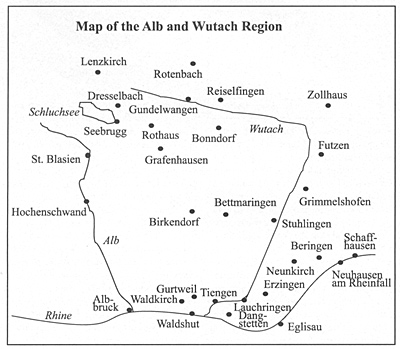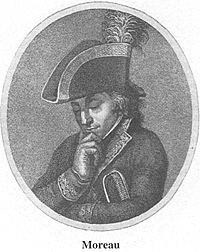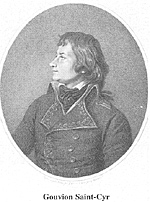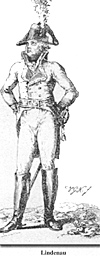Storming of the Alb River Position
28th April 1800
The Attack on the Alb
by Roland Kessinger, Germany
| |
The attack on the Alb was mainly carried out by 1st Battalion 14e demi-brigade legere, 1st and 2nd Battalion of 50e demi-brigade, 4e Hussars and 11e Chasseurs a Cheval. The cavalry advanced along the main road from Laufenburg to Albbruck, while the infantry moved over the ground to the north. The company of the Tyrolean Jäger and Zug of 10. Hussars under Hauptmann Mumb near Luttingen plus the 20 men of the 12. Light Battalion and Flügel (half-sqdn, but literally, wing) of 10. Hussars under Rittmeister Bedonarovich near Hochsaal were hopelessly out-numbered and soon forced back eastwards. Near Hauenstein, Austrian resistance stiffened after Oberst Mecsery had moved up with ½ sqdn 10. Hussars and the three Cavalry guns from Albbruck. A small clash followed near this village as the French attempted to push forward from Luttingen, joined by a French gun firing in support from the southern bank of the Rhine. The Austrian Cavalry guns turned their fire on this single piece and silenced it, before clearing the road and forcing the French to escape into the hills to the north. After this success, Oberst Mecsery positioned his Cavalry guns on a hill behind Albert, but he would be unable to hold his position for long. Around 0930, the French concentrated their forces and attacked again towards Hauenstein. French infantry advanced across the higher ground on Mecsery’s right, while his left was still under artillery fire from the other bank of the Rhine, forcing him to abandon his position. Around 1100, the first French units reached the Austrian entrenchments along the Alb river. Under orders to mount a determined defence, Oberst Mecery had already arranged the construction of many entrenchments and communication trenches around Albbruck. A large entrenchment, which had been built west of the Alb on the main road along the Rhine from Laufenburg to Albbruck, covered the crossing over the Alb river at Albbruck. Further entrenchments and defensive lines had been built east of the river on the left bank to prevent a French crossing.Informed that morning about the French advance, Mecsery had posted 1 co IR31, 2 cos 12. Light Battalion and 2 cos Landsturm in the large entrenchment towards Hauenstein, west of the Alb. 1 co 12. Light Battalion, 1 co Rovéréa, and 1 co Landsturm had occupied the bank of the Rhine and the communication trench leading to the river south of the entrenchment, while the Jäger company of IR Rovéréa together with the company of Tyrolean Jäger, which had pulled back from Luttingen, defended the area north of the entrenchment.
However, in the meantime, increasing numbers of small French detachments passed to the north of the entrenchment blocking the main road north along small tracks through the Black Forest woodland and quickly secured control of the tree covered ground north of the large entrenchment. In response, Hauptmann Seethal sent a Zug from IR31 to the entrenchment facing that woodland across the Alb. Once he received information that the French had actually reached the west bank of the Alb, Seethal despatched another Zug from IR31 north to rein-force this entrenchment. The Austrians were able to hold the large entrenchment and the Alb crossing until abou 1330, whena a detachment of 14e demi-brigade legere under Adjutant general Cohorn was able to cross the Alb and reach the west bank. As another French infantry assault rolled in against the large entrenchment west of the Alb, it was abandoned with two guns in panicked flight by the Austrian defenders, who also failed to blow the main bridge in the confusion. There are several eyewitness accounts of the storming of the large entrenchment. A few days later, people in the Swiss town of Schaffhausen claimed that the soldiers of the Swiss Rovéréa Battalion fought like “lions” while the Landsturm ran away after the first shot. Lieutenant Rovéréa, the son of the battalion’s commander, who led the Jäger company with Lieutenant von Erbach reported that his unit fought in skirmish formation until noon when he saw three French demi-brigades in closed columns moving towards the entrenchment. The number of demi-brigades is probably exaggerated and really means battalions, as French sources only specify the 1st Battalion 14e demi-brigade legere, and 1st & 2nd Battalions 50. demi-brigade as participating in the attack. Lieutenant Rovéréa continues to report that the French advanced in closed columns with music playing and flags flying as though on the pa-rade ground. When they reached about half the artillery’s range from the entrenchment, the Austrians evacuated their guns and then fled without firing a single shot. On the Alb river bridge, Oberst Mecsery was severely wounded by a shot through his leg, which only increased the chaos among the Austrian troops. Oberst Mecsery passed tactical command over the troops around Albbruck to Oberstleutnant Rubinitz, while Oberstleutnant Nordmann received administrative command over 10. Hussars. This new command structure shows again the partition in tactical and administrative command at below brigade level – when these small forces were led by men with administrative command of a single unit - Oberst Mecsery was responsible for 10. Hussars as their Colonel . However, on the 28th, he led only 4 squadrons of that regiment in the tactical sense, but also directed several infantry units, who were administratively responsible in an administrative way to other commanders, such as the six cos of IR31 (their regimental Colonel being Oberst Stahel). Such a split between tactical and administrative command was quite common in the Austrian army in 1799-1800 and was existed both above and below brigade level. RetreatFrom Albbruck the Austrian retreat, which sometimes turned into panicked , was conducted in two columns during the afternoon of the 28th. Two cos of the Rovéréa Battalion and about 2 squadrons of 10. Hussars went along the Upper Rhine to Waldshut. Of these, the infantry and a squadron rested briefly east of Waldshut at a monastery, before they followed the rest of the Hussars further east to where GM O’Donell was assembling his scattered troops on a stone bridge over the Wutach river. There a battalion of IR42 also joined his troops, making for a total of about 1,500 men. Major Morberth now formed an advance guard with 1 1/2 squadrons of 10. Hussars west of Tiengen, patrolling towards Waldshut and Gurtweil, while O’Donell sent his 12pdrs quickly back eastwards. The second column under Oberstleutnant Rubinitz with the main forces posted at Albbruck (3 cos 12. Light Battalion, 1 co Tyrolean Jäger, 3 cos IR31) fell back from Albbruck to Waldkirch. That evening, just 59 men of the 12. Light Battalion, 62 Tyrolean Jäger, 26 men from the Rovéréa Battalion and 150 soldiers from IR31 reached Waldkirch. During the night, Rubinitz established contact with the main forces of GM O’Donell between Tiengen and Lauchringen. Now, Morbeth’s line of Hussar pickets, covering Waldshut, Gurtweil and Tiengen, could be reinforced: 1 co Tyrolean Jäger was sent to Gurtweil, while ½ co 12. Light Battlion was ordered west of Tiengen and 1 co 12. Light Battalion was sent into Tiengen itself. In Waldshut, there was still only a Korporalsposten of Hussars, while in Waldkirch, only 4 men from the staff were left behind. Which way the Landsturm retreated is not known, but they probably made their own way in small groups. During the afternoon, FML Nauendorf had been informed about the French breakthrough on the Alb, so he ordered Oberst Stahel to send a division (2 sqdns) of 12. Light Dragoons and 3 cos IR42 to Unterlauchringen to support GM O’Donell. Additionally, he concentrated the 4 companies of 3rd Battalion IR31 on the Beringen and Neunkich hills to cover Schaffhausen. At 0100 on the 29th, Oberstleutnant Rubinitz and GM O’Donell were in Erzingen with their men camped east of Tiengen near Lauchringen, aside from the rearguard holding the Tiengen, Waldshut and Gurtweil outposts. At 0230, the 3 cos IR31 and the 2 squads 12. Light Dragoons, which Nauendorf had sent as reinforcements, arrived at Lauchringen and brought the order for GM O’Donell that if the French attacked in force, he was to retreat on to the Neunkirch hills and defend them as long as possible. However, on the 29th, the French didn’t push forward, so GM O’Donell could remain in position at Lauchringen and Bechtersbohl and the Austrians could set about stabilising their positions along the Upper Rhine. FML Nauendorf sent his chief of his staff, Oberst Jurcick, to GM O’Donell to assist him in reorganising his troops. It seems that GM O’Donell was not coping well with the difficult situation and was becoming depressive -- FML Nauendorf was thus happy to hear that GM Fürst Rosenberg would arrive on the 30th to take over the tactical command over the troops around Lauchringen.
Events at HochenschwandAfter the attack on Freiburg had been cancelled during the night of 27/28th, Oberstleutnant Nordmann returned to Hochenschwand with his outposts, where he would be under orders to hold his position in any event. Rittmeister Vlasits, who had been directed by GM Gyulai to maintain the link with Nordmann at St. Blasien, had also sent his own patrols into the Wiese valley. During the morning of the 27th everything remained quiet at Hochenschwand, Seebrugg and in front of GM Gyulai. Even when the French attacked Albbruck, Nordmann didn’t see any significant French movement in the Wiese valley or on the Alb near Hochenschwand. However, the Austrians were aware of a French column comprising several thousand men passing Schonau. This was part of the 3rd Division, which moved on from Zell, Mambach, Schonau, and Utzenfeld towards St. Blasien during the day. Only a small detachement of that Division occupied Todtnau to maintain contact with St. Cyr’s corps.
At 2230, GM O’Donell sent another message to GM Archduke Ferdinand informing him that he should now direct Oberstleutnant Nordmann’s troops. Events at Albbruck seem to be behind a sudden change in the tactical command within the Nauendorf’s corps. In the morning, GM Archduke Ferdinand was responsible for the whole outpost chain along the Alb under Oberst Mecsery. After the French breakthrough, GM O’Donell took over the tactical command over most of these troops, while GM Archduke Ferdinand retained the detachment under Oberstleutnant Nordmann in the camp near Bonndorf. During the night of 28/29th, Nordmann reached Birkendorf with his troops and arrived in person at 5:00 on the 29th in Bettmaringen. During the night more than half of his two Landsturm companies deserted, even though the units were kept in reserve during the day and saw no action. The brigade under GM Archduke Ferdinand now stood along the line Seebrugg-Rothaus-Grafenhausen-Birkendorf. It is unclear how Obristwachtmeister Spauer retreated from Unteralpfen – an order was sent by GM O’Donell that he should move to Bettmaringen, too, but it is not clear whether it was carried out. At 0200 on the 29th, GM Archduke Ferdinand was still around Bonndorf with six cos IR31, three cos IR42, two cos of the Rovéréa Battalion, 4 squadrons of 10. Hussars and two squadrons of 12. Light Dragoons, while Oberstleutnant Nordmann had concentrated two cos IR31, a company of Tyrolean Jäger, two cos 12. Light Battalion and two cos Landsturm (from the districts of Zell and St. Blasien) at Birkendorf. Ferdinand feared that he would be unable to cover the key position of Bonndorf with these troops and asked FZM Kray and FML Nauendorf for reinforcements. Reinforcements
At 2200 on the 28th, FZM Kray informed Nauendorf and Ferdinand of Lindenau’s march to Zollhaus. At the same time, GM Gyulai was ordered to send back two battalions of IR22 Lacy and 9. Nassau Kurassier to occupy Reiselfingen and the hills around Rotenbach to cover the Archduke’s right. The rest of the main force of GM Gyulai’s brigade was to cover the Archduke at Lenzkrich. When Archduke Ferdinand became aware of FML Lindenau’s approach, he immediately asked Kray, Nauendorf, and Lindenau for reinforcement. FML Lindenau answered that he couldn’t do anything without Nauendorf’s instructions, since he was now allocated to the FML’s command. However, during the morning of the 29th, FZM Kray ordered FML Lindenau to send 2nd Battalion of IR2 and 4 squads 2. Uhlans to Bonndorf, (where they arrived during the evening) and 1 battalion IR3 and 2 squads 2. Uhlans to Bettmaringen, while deploying the rest of his troops as FML Nauendorf and GM Archduke Ferdinand required. At 1515, FML Nauendorf ordered FML Lindenau to send a Flügel of 2. Uhlans to Stuhlingen, a Zug of 5. Kurassier to Grimmelshofen and a Zug of 5 Kurassier to Futzen. These troops were to maintain contact FML Lindenau’s troops and the units around Lauchringen. The distribution of FML Lindenau’s troops had some influence on the later events of the campaign, when Lecourbe’s corps crossed the Rhine on 1st May and Moreau defeated Kray at the battles of Engen (3rd May), Messkirch (5th May), Biberach (9th May), and Memmingen (10th May). However, the story of the storming of the Alb position ends here. It should demonstrate how flexibly the Austrians reacted to new situations, but how extensive the resulting discussions could be in the Austrian army at time (and the handovers seem to have caused problems). This flexible approach could cause confusion and unnecessary correspondence, with the consequent delays this might have caused. Sources and Further ReadingÖsterreichisches Staatsarchiv - Kriegsarchiv Wien, Allgemeine Feldakten, Deutschland, 1800/4/96 – 218 Ernest Picard; La Campagne de 1800 en Allemagne, Tome I., Paris, 1907
Storming of the Alb River Position 28th April 1800
26th and 27th of April Attack on the Alb Order of Battle: French Back to Table of Contents -- First Empire # 73 Back to First Empire List of Issues Back to MagWeb Master Magazine List © Copyright 2003 by First Empire. This article appears in MagWeb.com (Magazine Web) on the Internet World Wide Web. Other articles from military history and related magazines are available at http://www.magweb.com |
 Oberst Mecsery had intended to meet GM O’Donell at Dogern on the morning of the 28th, to formalise the change of the tactical command from GM Archduke Ferdinand to GM O’Donell. However, this meeting never took place as the French started their attack on the Alb river: Their 1st Division was ordered to leave the camp at Murg at 0700 and push their advance guard up to Waldshut during the day, followed by the 2nd Division. The French were a little delayed, but broke camp around 0800 in the morning of the 28th with 4,000 infantry and two cavalry brigades.
Oberst Mecsery had intended to meet GM O’Donell at Dogern on the morning of the 28th, to formalise the change of the tactical command from GM Archduke Ferdinand to GM O’Donell. However, this meeting never took place as the French started their attack on the Alb river: Their 1st Division was ordered to leave the camp at Murg at 0700 and push their advance guard up to Waldshut during the day, followed by the 2nd Division. The French were a little delayed, but broke camp around 0800 in the morning of the 28th with 4,000 infantry and two cavalry brigades.
 East of the Alb remained 2 cos IR31 (under Hauptmann Seethal, who commanded all 3 cos IR31) and 2 cos IR Rovéréa (presumably under Major Driesbach who commanded both companies around Albbruck) as a reserve to man the entrenchments and lines there. FML Nauendorf had also received reports of the French advance and ordered one battalion IR42, which was near Tiengen on the Rhine, to concentrate on the Dangstetten hills to form a reserve for the units at Albbruck. More and more French forces were head-ing for the Alb itself. Mecsery now feared they would break through his lines on his right at Niederwihl and Immeneich, as he believed the French could move through the woodland on the Black Forest hillseides. So he sent one howitzer and one 6pdr from the large entrenchment across the Alb, once his three Cavalry guns in to replace them in the fortification, which also held two 3pdrs and one 6pdr. Well dug in, the Austrians were able to repel the French attacks made by 1st Battalion 14e demi-brigade legere with 1st and 2nd Battalions 50e demi-brigade along the Laufenburg-Albbruck road for approximately one hour.
East of the Alb remained 2 cos IR31 (under Hauptmann Seethal, who commanded all 3 cos IR31) and 2 cos IR Rovéréa (presumably under Major Driesbach who commanded both companies around Albbruck) as a reserve to man the entrenchments and lines there. FML Nauendorf had also received reports of the French advance and ordered one battalion IR42, which was near Tiengen on the Rhine, to concentrate on the Dangstetten hills to form a reserve for the units at Albbruck. More and more French forces were head-ing for the Alb itself. Mecsery now feared they would break through his lines on his right at Niederwihl and Immeneich, as he believed the French could move through the woodland on the Black Forest hillseides. So he sent one howitzer and one 6pdr from the large entrenchment across the Alb, once his three Cavalry guns in to replace them in the fortification, which also held two 3pdrs and one 6pdr. Well dug in, the Austrians were able to repel the French attacks made by 1st Battalion 14e demi-brigade legere with 1st and 2nd Battalions 50e demi-brigade along the Laufenburg-Albbruck road for approximately one hour.
 The Austrians lost about 200 men in the fighting around the Alb river, whereas the French 1st Division lost about 90 men of the 1st division. Their 2nd division didn’t come into fire and moved only from Wehr in the region of Laufenburg. Moreau was satisfied with the result. He had anticipated that the actions on the Alb river would only be advance-guard clashes, but as he mentioned in a letter to St. Cyr, he thought that his units had been tactically superior. The French had won a victory on the Alb, which had important consequences on the rest of the Austrian army.
The Austrians lost about 200 men in the fighting around the Alb river, whereas the French 1st Division lost about 90 men of the 1st division. Their 2nd division didn’t come into fire and moved only from Wehr in the region of Laufenburg. Moreau was satisfied with the result. He had anticipated that the actions on the Alb river would only be advance-guard clashes, but as he mentioned in a letter to St. Cyr, he thought that his units had been tactically superior. The French had won a victory on the Alb, which had important consequences on the rest of the Austrian army.
 Around 1800 in the evening, a small outpost clash started at St. Blasien between Nordmann’s rearguard and the head of the column of the 3rd division (Richepance). The Austrians were pushed back slowly towards Hausern while they lost 28 prisoners. Approximately at 2100, the French reached Hochenschwand. During the night the main body of the 3rd division camped around St. Blasien. GM Archduke Ferdinand had been informed about the events at Albbruck during the afternoon. So, without awaiting further orders from FML Nauendorf, the Archduke ordered Nordmann to retreat from Hochenschwand to Birkendorf. That evening, Ferdinand was still waiting for orders from FML Nauendorf, having not been informed that at 1500, Nauendorf had advised Kray to send orders directly to the Archduke. It was only late in the evening that a message from Kray, confirming the new arrangements, reached the Archduke.
Around 1800 in the evening, a small outpost clash started at St. Blasien between Nordmann’s rearguard and the head of the column of the 3rd division (Richepance). The Austrians were pushed back slowly towards Hausern while they lost 28 prisoners. Approximately at 2100, the French reached Hochenschwand. During the night the main body of the 3rd division camped around St. Blasien. GM Archduke Ferdinand had been informed about the events at Albbruck during the afternoon. So, without awaiting further orders from FML Nauendorf, the Archduke ordered Nordmann to retreat from Hochenschwand to Birkendorf. That evening, Ferdinand was still waiting for orders from FML Nauendorf, having not been informed that at 1500, Nauendorf had advised Kray to send orders directly to the Archduke. It was only late in the evening that a message from Kray, confirming the new arrangements, reached the Archduke.
 When FZM Kray was informed about the French breakthrough on the Alb river, he despatched FML Lindenau from Donaueschingen to Zollhaus with IR2, IR3 Erzherzog Karl, 2. Uhlans and 5. Zeschwitz Kurassier to reinforce FML Nauendorf’s corps. Lindenau would then deploy his men as Nauendorf ordered. Here again, Nauendorf is being allowed to operate independently, with reinforcements being sent by Army HQ being placed under hhis own command on arrival. Nauendorf now had the additional divisions under Lothringen and Lindenau at his disposal. It is straightforward (and contrary to popular mythology) to see how the Austrians reinforced their separate corps formations and devolved command to the local Generals.
When FZM Kray was informed about the French breakthrough on the Alb river, he despatched FML Lindenau from Donaueschingen to Zollhaus with IR2, IR3 Erzherzog Karl, 2. Uhlans and 5. Zeschwitz Kurassier to reinforce FML Nauendorf’s corps. Lindenau would then deploy his men as Nauendorf ordered. Here again, Nauendorf is being allowed to operate independently, with reinforcements being sent by Army HQ being placed under hhis own command on arrival. Nauendorf now had the additional divisions under Lothringen and Lindenau at his disposal. It is straightforward (and contrary to popular mythology) to see how the Austrians reinforced their separate corps formations and devolved command to the local Generals.